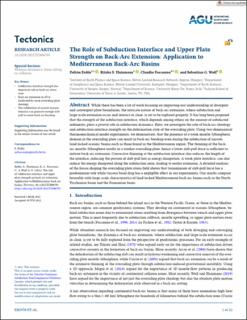| dc.description.abstract | While there has been a lot of work focusing on improving our understanding of divergent and convergent plate boundaries, the intricate nature of back-arc extension, where subduction and large-scale extension occur and interact in close, is yet to be explored properly. It has long been proposed that the strength of the subduction interface, which depends among others on the amount of subducted sediments, plays a pivotal role in subduction dynamics. Here, we investigate the role of back-arc rheology and subduction interface strength on the deformation style of the overriding plate. Using two-dimensional thermomechanical model experiments, we demonstrate, that the presence of a weak mantle–lithospheric domain in the overriding plate can result in back-arc breakup even during the subduction of narrow, land-locked oceanic basins such as those found in the Mediterranean region. The thinning of the back-arc mantle–lithosphere results in a weaker overriding plate, hence a lower slab-pull force is sufficient to initiate back-arc extension. Convective thinning at the subduction interface also reduces the length of the interface, reducing the portion of slab-pull lost as energy dissipation. A weak plate interface, can also reduce the energy dissipated along the subduction zone, leading to earlier extension. A detailed analysis of the forces shaping the overriding plate stress field shows that transmission of slab-pull force has a predominant role while viscous basal drag has a negligible effect in our experiments. Our results compare favorably with large-scale characteristics of land-locked Mediterranean back-arc basins such as the North Tyrrhenian basin and the Pannonian basin. | en_US |

